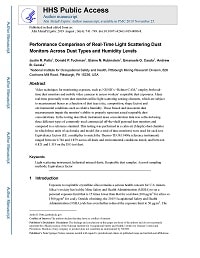Mining Publication: Performance Comparison of Real-Time Light Scattering Dust Monitors Across Dust Types and Humidity Levels
Original creation date: November 2019
Authors: J Patts, D Tuchman, E Rubinstein, E Cauda, A Cecala
Video techniques for monitoring exposure, such as NIOSH’s “Helmet-CAM,” employ both real-time dust monitors and mobile video cameras to assess workers’ respirable dust exposures. Many real-time personally worn dust monitors utilize light scattering sensing elements, which are subject to measurement biases as a function of dust type (size, composition, shape factor) and environmental conditions such as relative humidity. These biased and inaccurate dust measurements impair the monitor’s ability to properly represent actual respirable dust concentrations. In the testing described, instrument mass concentration data was collected using three different types of commonly used commercial off-the-shelf personal dust monitors and compared to a reference standard. This testing was performed in a calm air (Marple) dust chamber in which three units of each make and model (for a total of nine monitors) were used for each test. Equivalency factors (EF, a multiplier to match the Thermo TEOM 1400a reference instrument) ranged between 0.746 and 1.879 across all dusts and environmental conditions tested, and between 0.821 and 1.519 on the ISO test dust.

- Determining the Spatial Variability of Personal Sampler Inlet Locations
- Equivalency of a Personal Dust Monitor to the Current United States Coal Mine Respirable Dust Sampler
- Laboratory and Field Performance of a Continuously Measuring Personal Respirable Dust Monitor
- Laboratory Evaluation of Pressure Differential-based Respirable Dust Detector Tube
- Miners' Views about Personal Dust Monitors
- Miners' Views About Personal Dust Monitors
- Performance of a Light Scattering Dust Monitor at Various Air Velocities: Results of Sampling in the Active Versus the Passive Mode
- Performance of a Light-scattering Dust Monitor in Underground Mines
- Real-Time DPM Ambient Monitoring in Underground Mines
- The Use of Light Scattering and Ion Chamber Responses for the Detection of Fires in Diesel Contaminated Atmospheres